As the 2023/24 English football season draws to a close, we are starting to learn which teams will be joining and departing several leagues. We know Sheffield United will rejoin the Championship, Mansfield Town will play League One football next season, and Chesterfield’s title-winning campaign will see them re-enter the EFL for the 2024/25 campaign.
Joining the Spireites in League Two will be Bromley, who recently beat Solihull Moors on penalties at Wembley to earn promotion. This means the club will play in the EFL for the first time in its 133rd year. This historic victory came after two previous failed playoff campaigns in the National League, but this season, Andy Woodman’s squad was able to seal the deal.
This scout report will provide a tactical analysis of Bromley’s tactics used this season as we look to highlight just how they were able to record a third-place finish on 81 points, with the division’s best defensive record. Please note that any data included in this article going forward does include Bromley’s playoff fixtures as well as the 46 league games.
Mid-block & Counterpress
Defensive discipline is one of the key ingredients in Woodman’s tactics at Bromley, which is why they had the division’s best defensive record, conceding 49 goals pre-play-offs. His side registered an average possession of 41.9% this season – the second lowest in the National League. On top of that, they recorded the division’s lowest challenge intensity (5.2) and third-highest PPDA (13.54) – all indications of a team that likes to invite pressure deeper than the front line. Despite the data suggesting a lack of aggression, Bromley don’t like to sit deep and instead, utilise a well-structured mid-block which protects the backline nicely.
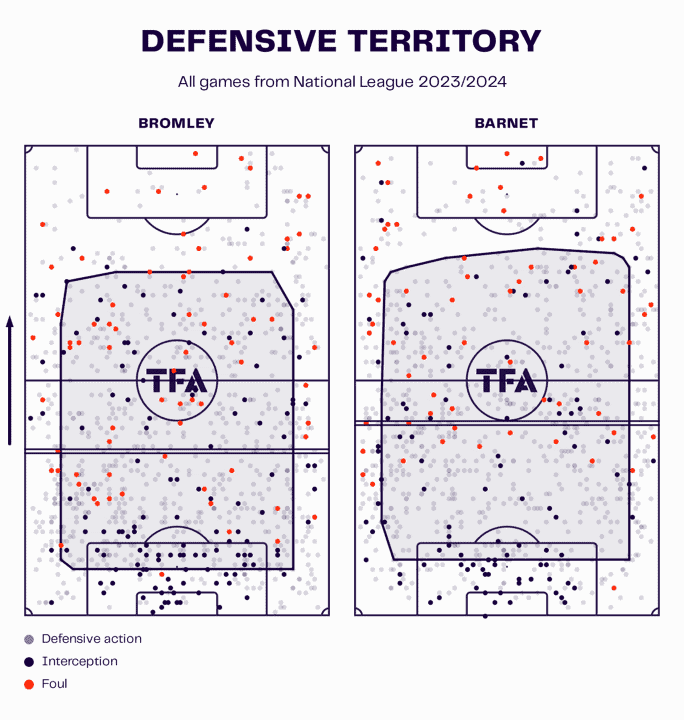
Before dissecting Bromley’s mid-block, let’s investigate their defensive territory to get a stronger sense of where they like to operate. We’ve compared their defensive territory to that of Barnet – a team who rank high for various pressing metrics as well as possession – a ball-dominant team who are aggressive off the ball. As you can see, the difference in territory is not that great, an indicator that Bromley aren’t the type to park the bus. But, as we will come to discuss, they aren’t a high-pressing team either.
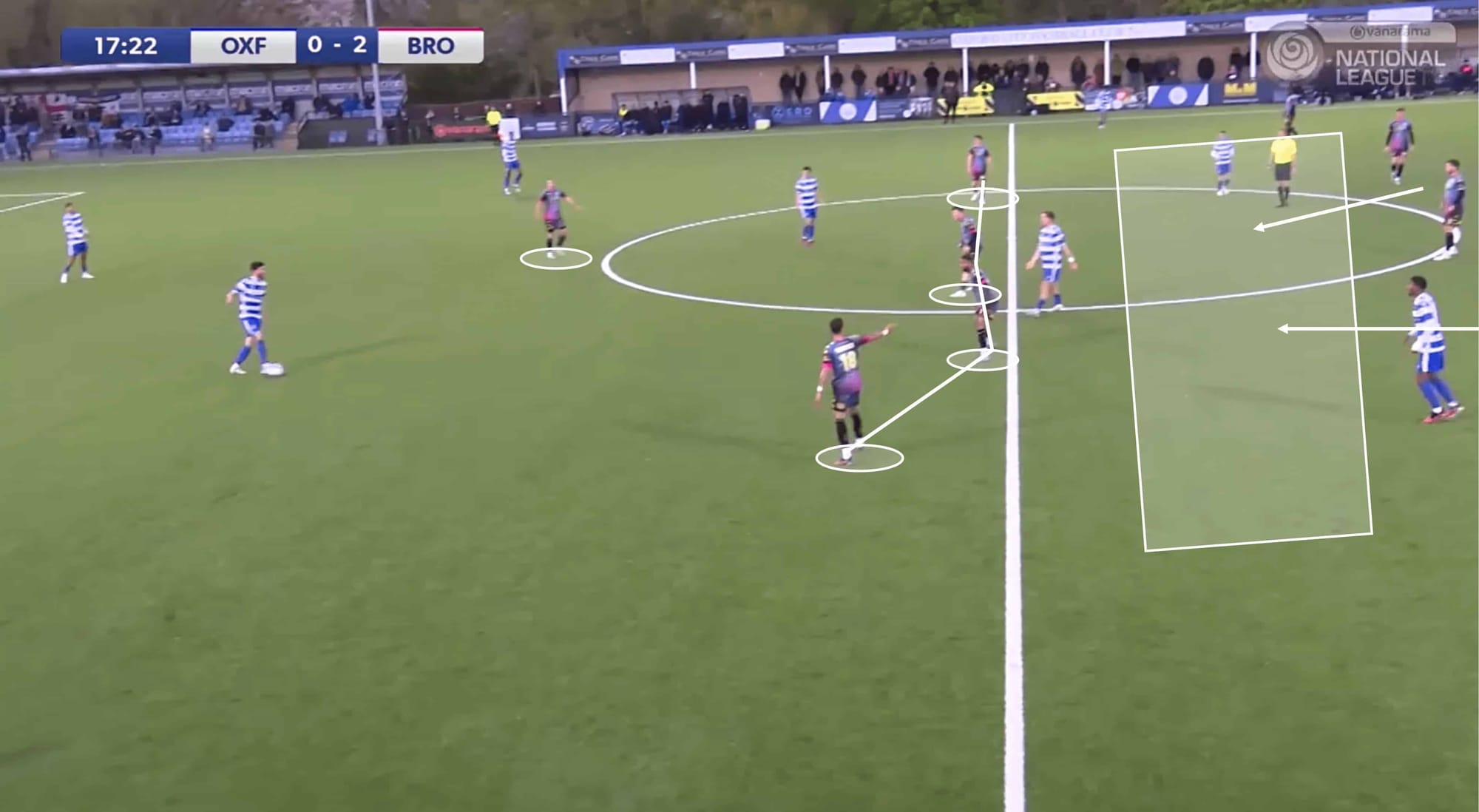
This is what you can typically expect from Bromley when facing opposition possession. There are a few key points to talk about here, starting with the formation. In this game, they deployed a 5-4-1, which is clear to see in the image above. Most of the time, though, throughout the season, they’ve been known to use 3-5-2/5-3-2. The message here is that regardless of the formation, the principles often remain unchanged.
Notice how the centre-forward is not engaging with the ball or the opposition—something Bromley fans are used to seeing when their team doesn’t have possession. His role is to latch onto loose passes, poor touches, etc., and to be in a good supporting position in the event of a turnover in possession.
Now, the midfield. They like to remain compact with the aim of blocking those line-breaking, penetrating passes from deeper positions. However, should that pass break the midfield line, the distance between the midfield unit and the backline is short enough to deny the opposition a strong opportunity to take advantage. If the pass makes it into the highlighted zone successfully, you can expect a Bromley CB to be in there quickly to push the forward and the ball backwards.
And if the opposition want to try and get down the flanks, the midfield will shift over to that flank, maintaining a compact shape. While the nearest midfielder plays an important role, the wing-back often engages with the opposition attacking winger.
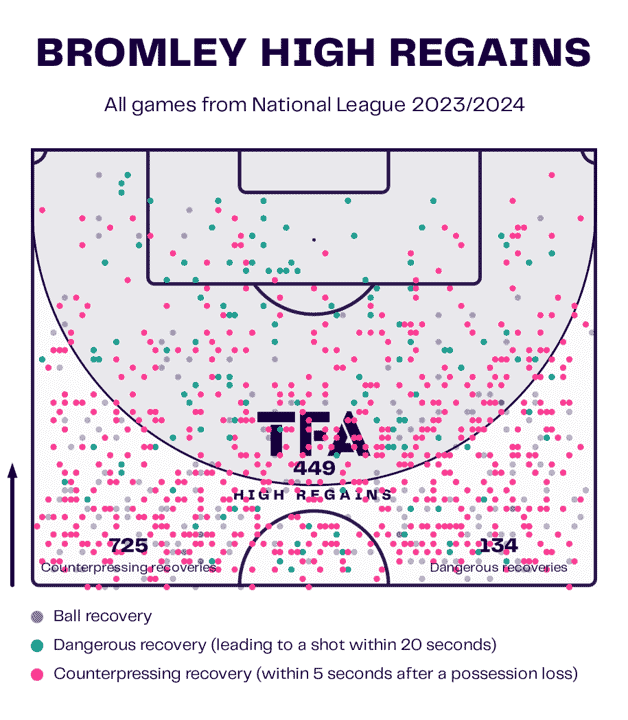
As mentioned, you won’t often see Bromley execute a high-pressing system, but that is not to say they are docile out-of-possession. They have constantly displayed the ability to win the ball in high areas—their season total of 449 high regains is just 14 short of Barnet’s total—but counterpressing is where Bromley shows the highest level of competency.
725 counterpressing recoveries in the National League this season should tell you a lot about Andy Woodman’s tactics at Bromley—that number exceeds Barnet’s total by 12, which also shows that you can’t judge a team’s defensive style based purely on select isolated statistics.
Key attacking points
Bromley’s strong defensive output is nothing but a continuation of their 22/23 campaign. However, their lack of ability to match the attacking output of teams around them has also carried over to this season. But let’s get one thing straight—we aren’t calling Bromley a poor attacking side—far from it. They’ve scored 73 goals in the league (before the playoffs), averaging 1.47 goals per 90 (including playoff games), which is the league’s sixth-best goalscoring rate.
The point is that they aren’t like your Chesterfields or Notts Countys, but Bromley’s ability to maintain a strong tactical balance is a huge factor in their success this season. The fact remains, though, that they will certainly have to find more attacking impetus next season in a higher division.
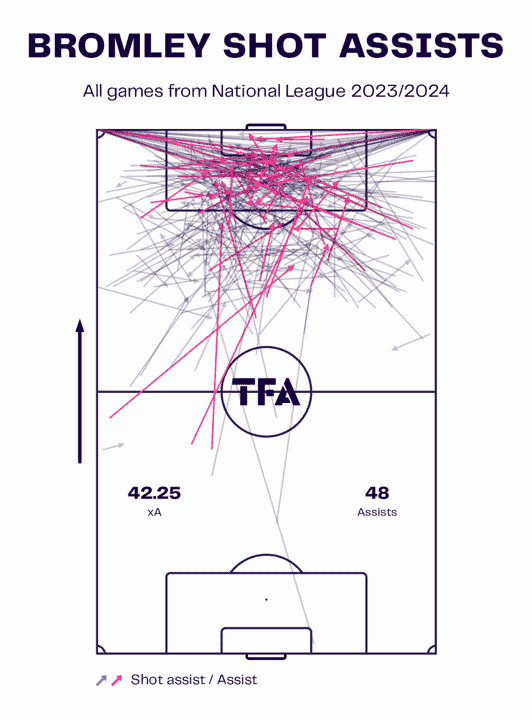
We start this segment of the tactical analysis with a view of Bromley’s shot assists. As you may guess from the general location of assists, they rank fairly low for cross attempts per 90, with many of their goals from open play being built from central areas. That’s not to say they aren’t effective from wide areas or aerial attacks – they’re one of the division’s best from attacking set-pieces, as we will come to discuss later.
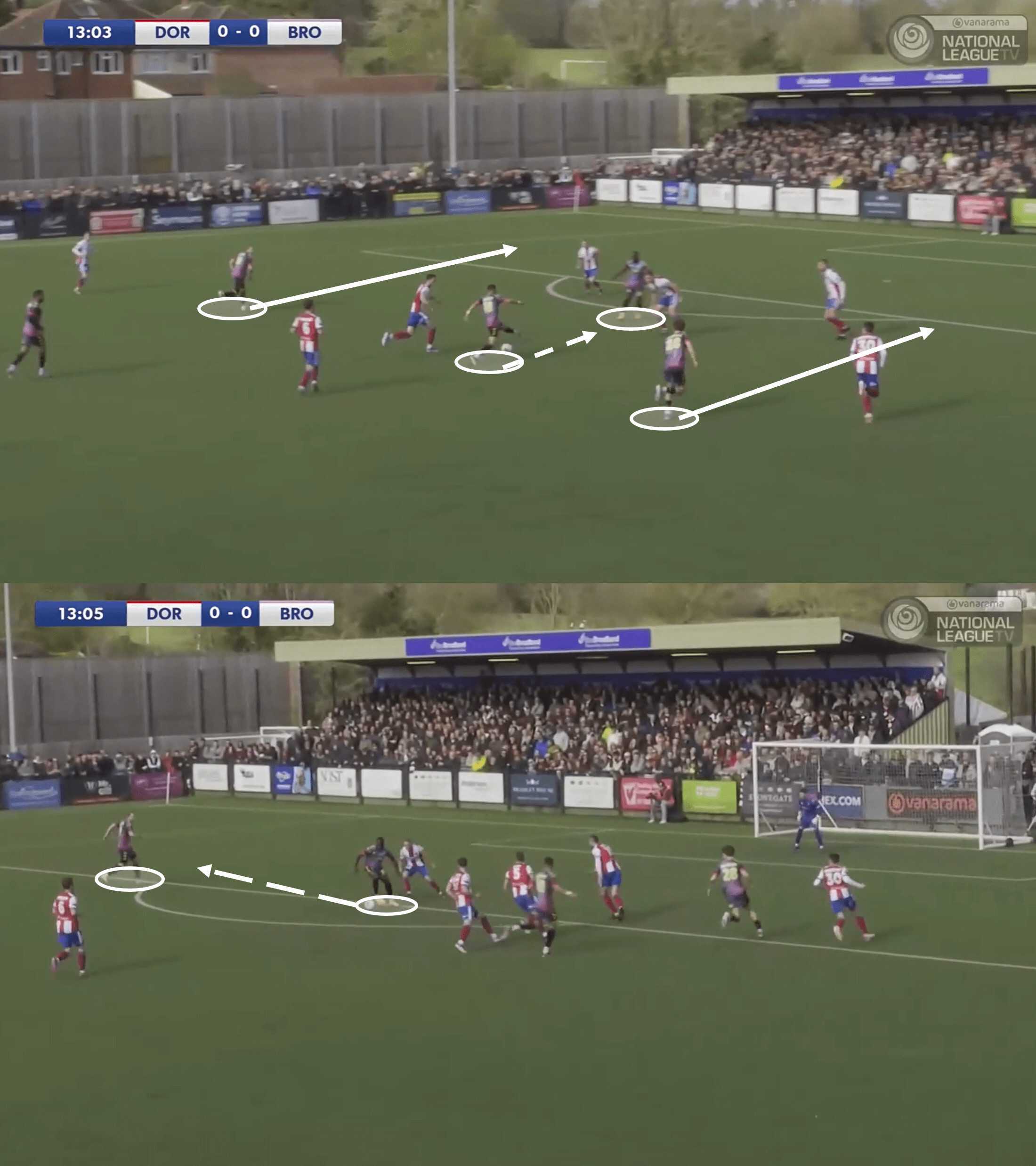
As we touched upon, building chances from central areas is a key theme within Bromley’s attacking tactics. They don’t get a huge deal of chances in front of goal – 9.73 shots per 90 tell us that, but they show a good attacking edge to carve out chances through the centre by utilising good off-the-ball movement, particularly when capitalising on a successful counterpress.
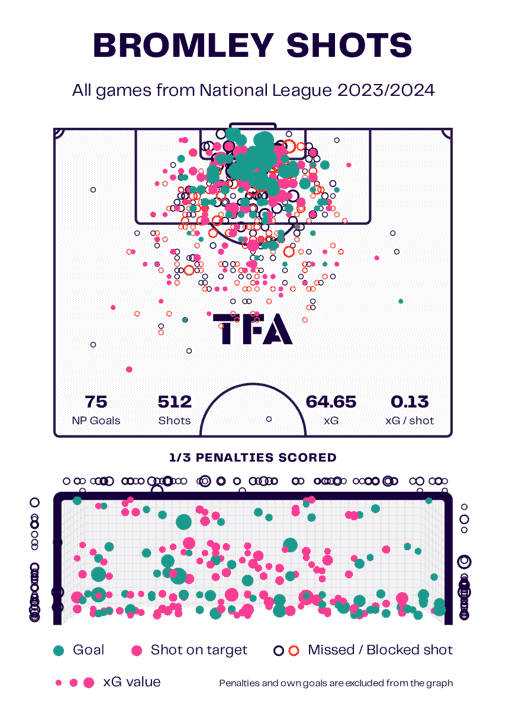
Long shots may not enter many minds when you think of various attacking tactics – to some, they may just be used as a last-ditch attempt or a hopeful hit on goal, but Bromley seems to lean on long-range efforts fairly regularly. They scored an impressive 14 goals from outside the box this season – only four teams in the NL topped that, but when you consider that’s 17.95% of their total goal tally (including playoff goals), it becomes even more impressive and intriguing.
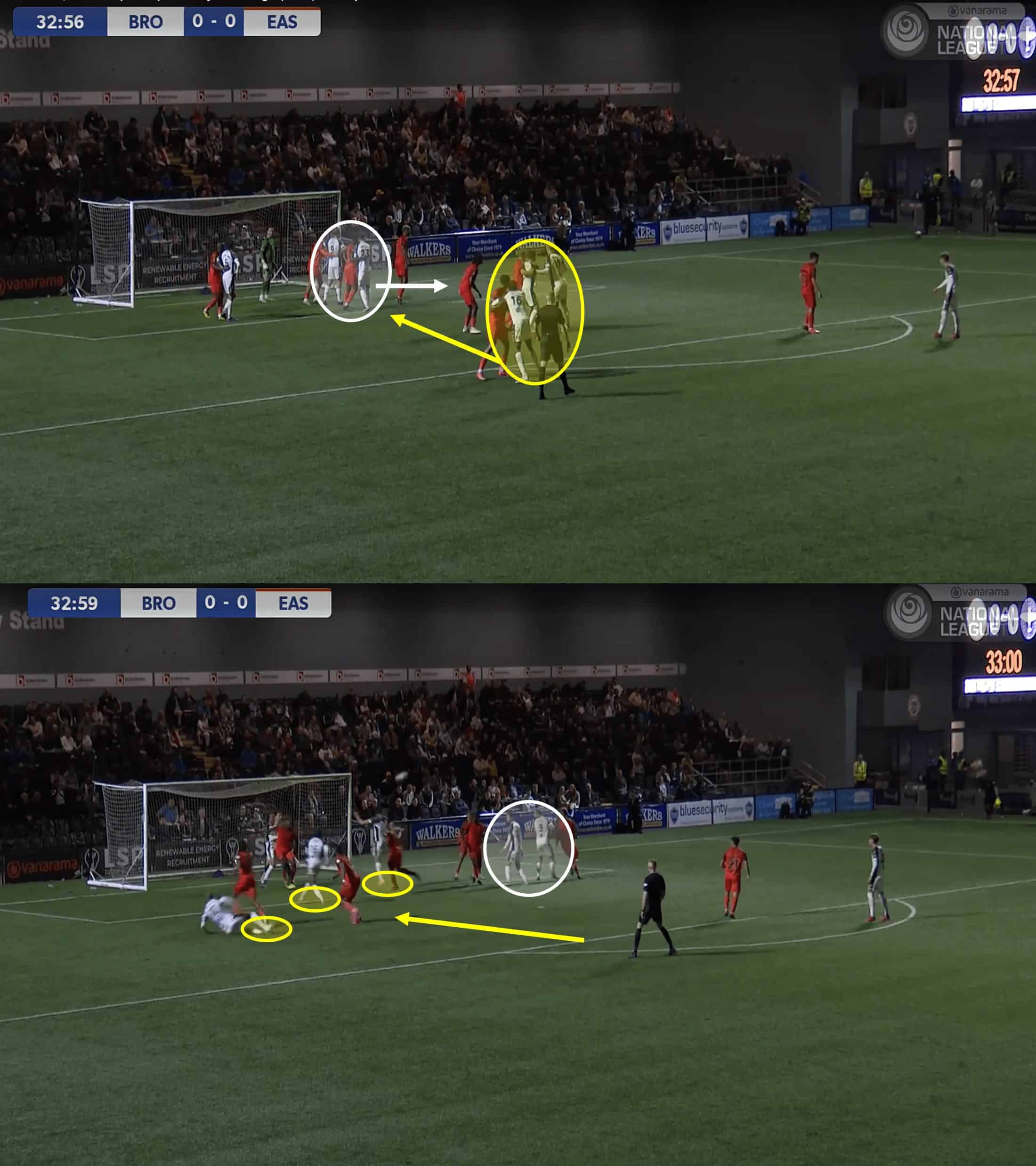
Set play speciality has been a hot topic in football recently, particularly in English football. Several teams hold it high on their priorities—Arsenal, for example, have received a lot of positive media attention for their goalscoring prowess from corners this season.
Bromley also have set-piece danger in their arsenal, having bagged from 12 corners this season. There don’t seem to be any noticeable consistent patterns in terms of delivery or positioning within the box, but they do have several well-thought-out plays—one of them is above.
The two attackers (highlighted in white) begin the sequence in the six-yard box – a dangerous area from a corner. However, as the corner taker proceeds to deliver the ball, the two attackers peel away from the danger zone with the aim of dragging opposition bodies with them to create space and chaos within the six-yard box. And that was the exact result on this occasion – with the players highlighted yellow making an exchanging run with the attackers in the six-yard box, with the ball finding its way into the back of the net.
Bromley’s aerial ability has also been seen to come in handy from long throws, another attacking weapon they’ve successfully utilised on multiple occasions. In fact, their aerial ability is reliable across the pitch, it would seem—their win rate of 49.6% is the third highest in the National League.
Conclusion
Bromley have achieved a historic promotion with refreshing tactics – tactics that aren’t possession-reliant in the National League, something that could be vital in their ability to adjust to life in League Two. While teams can come up from the NL playing a possession-based game and adjust well to League Two, we see numerous teams being exposed as a result. Notts County are arguably the most recent example, with their defensive weaknesses being exposed despite the club operating under possession-dominant tactics (not that the two are directly linked).
Andy Woodman has instilled a pleasing tactical balance into this group of players, which has undoubtedly played a pivotal role in their strong campaign, resulting in promotion. They aren’t short of confidence either, as a group of players – skipper Byron Webster was the epitome of this in the playoff final, looking ice-cold as he stepped up for his promotion-winning penalty while wearing an EFL captain’s armband – reportedly something the defender has done all season long! That character and confidence could come in extremely handy in those tricky League Two games next season.

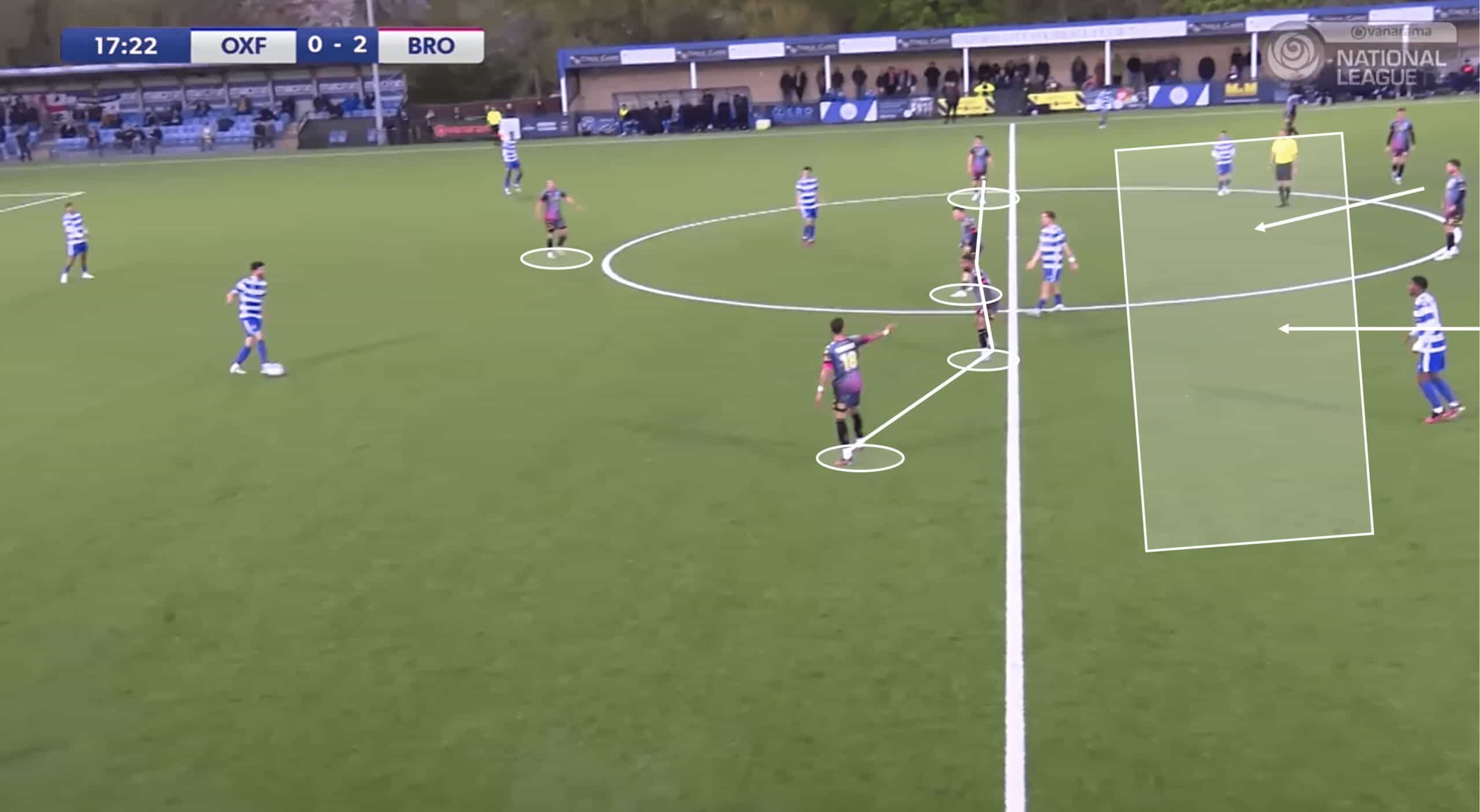




Comments